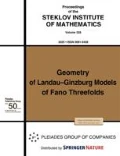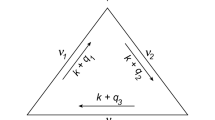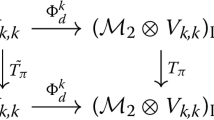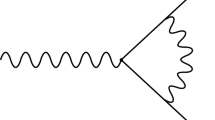Abstract
We consider a univariate beta integral composed of general modular quantum dilogarithm functions and prove its exact evaluation formula. It represents the partition function of a particular 3d supersymmetric field theory on the general squashed lens space. Its possible applications to 2d conformal field theory are briefly discussed as well.
Similar content being viewed by others
References
S. Alexandrov and B. Pioline, “Theta series, wall-crossing and quantum dilogarithm identities,” Lett. Math. Phys. 106 (8), 1037–1066 (2016).
J. E. Andersen and R. Kashaev, “Complex quantum Chern-Simons,” arXiv: 1409.1208 [math.QA].
G. E. Andrews, R. Askey, and R. Roy, Special Functions (Cambridge Univ. Press, Cambridge, 1999), Encycl. Math. Appl. 71.
V. V. Bazhanov, V. V. Mangazeev, and S. M. Sergeev, “Faddeev-Volkov solution of the Yang-Baxter equation and discrete conformal symmetry,” Nucl. Phys. B 784 (3), 234–258 (2007).
V. V. Bazhanov, V. V. Mangazeev, and S. M. Sergeev, “Exact solution of the Faddeev-Volkov model,” Phys. Lett. A 372 (10), 1547–1550 (2008).
M. A. Bershtein, V. A. Fateev, and A. V. Litvinov, “Parafermionic polynomials, Selberg integrals and three-point correlation function in parafermionic Liouville field theory,” Nucl. Phys. B 847, 413–459 (2011).
N. N. Bogolyubov and D. V. Shirkov, Introduction to the Theory of Quantized Fields, 3rd ed. (Nauka, Moscow, 1976; J. Wiley & Sons, New York, 1980); 4th ed. (Nauka, Moscow, 1984).
G. Bonelli, K. Maruyoshi, A. Tanzini, and F. Yagi, “N = 2 gauge theories on toric singularities, blow-up formulae and W-algebrae,” J. High Energy Phys. 2013 (01), 014 (2013).
F. J. van de Bult, E. M. Rains, and J. V. Stokman, “Properties of generalized univariate hypergeometric functions,” Commun. Math. Phys. 275 (1), 37–95 (2007).
A. G. Bytsko and J. Teschner, “Quantization of models with non-compact quantum group symmetry: Modular XXZ magnet and lattice sinh-Gordon model,” J. Phys. A: Math. Gen. 39 (41), 12927–12981 (2006).
D. Chicherin and S. Derkachov, “The R-operator for a modular double,” J. Phys. A: Math. Theor. 47 (11), 115203 (2014).
D. Chicherin and V. P. Spiridonov, “The hyperbolic modular double and the Yang-Baxter equation,” in Representation Theory, Special Functions and Painvlevé Equations — RIMS 2015 (Math. Soc. Japan, Tokyo, 2018), Adv. Stud. Pure Math. 76, pp. 95–123.
T. Dimofte, “Complex Chern-Simons theory at level k via the 3d-3d correspondence,” Commun. Math. Phys. 339 (2), 619–662 (2015).
T. Dimofte, D. Gaiotto, and S. Gukov, “Gauge theories labelled by three-manifolds,” Commun. Math. Phys. 325 (2), 367–419 (2014).
F. A. Dolan and H. Osborn, “Applications of the superconformal index for protected operators and q-hypergeometric identities to N = 1 dual theories,” Nucl. Phys. B 818 (3), 137–178 (2009).
F. A. H. Dolan, V. P. Spiridonov, and G. S. Vartanov, “From 4d superconformal indices to 3d partition functions,” Phys. Lett. B 704 (3), 234–241 (2011).
M. Eichler and D. Zagier, The Theory of Jacobi Forms (Birkhäuser, Boston, 1985), Prog. Math. 55.
L. Faddeev, “Currentlike variables in massive and massless integrable models,” in Quantum Groups and Their Applications in Physics (IOS Press, Amsterdam, 1996), Proc. Int. Sch. Phys. “Enrico Fermi” 127, pp. 117–135.
L. D. Faddeev, “Discrete Heisenberg-Weyl group and modular group,” Lett. Math. Phys. 34 (3), 249–254 (1995).
V. Fateev, A. Zamolodchikov, and Al. Zamolodchikov, “Boundary Liouville field theory. I: Boundary state and boundary two-point function,” arXiv: hep-th/0001012.
I. Gahramanov and A. P. Kels, “The star-triangle relation, lens partition function, and hypergeometric sum/integrals,” J. High Energy Phys. 2017 (02), 040 (2017).
L. Griguolo, D. Seminara, R. J. Szabo, and A. Tanzini, “Black holes, instanton counting on toric singularities and q-deformed two-dimensional Yang-Mills theory,” Nucl. Phys. B 772 (1-2), 1–24 (2007).
N. Hama, K. Hosomichi, and S. Lee, “SUSY gauge theories on squashed three-spheres,” J. High Energy Phys. 2011 (05), 014 (2011).
S. K. Hansen and T. Takata, “Reshetikhin-Turaev invariants of Seifert 3-manifolds for classical simple Lie algebras,” J. Knot Theory Ramifications 13 (5), 617–668 (2004).
Y. Imamura, H. Matsuno, and D. Yokoyama, “Factorization of the S3/ℤn partition function,” Phys. Rev. D 89 (8), 085003 (2014).
Y. Imamura and D. Yokoyama, “S3/ℤn partition function and dualities,” J. High Energy Phys. 2012 (11), 122 (2012).
A. Kapustin, B. Willett, and I. Yaakov, “Exact results for Wilson loops in superconformal Chern-Simons theories with matter,” J. High Energy Phys. 2010 (03), 089 (2010).
R. Kashaev, “The quantum dilogarithm and Dehn twists in quantum Teichmüller theory,” in Integrable Structures of Exactly Solvable Two-Dimensional Models of Quantum Field Theory, Ed. by S. Pakuliak and G. von Gehlen (Kluwer, Dordrecht, 2001), NATO Sci. Ser. II: Math. Phys. Chem. 35, pp. 211–221.
R. M. Kashaev, “Beta pentagon relations,” Theor. Math. Phys. 181 (1), 1194–1205 (2014) [transl. from Teor. Mat. Fiz. 181 (1), 73–85 (2014)].
R. Kashaev, “The Yang-Baxter relation and gauge invariance,” J. Phys. A: Math. Theor. 49 (16), 164001 (2016).
R. Kashaev, F. Luo, and G. Vartanov, “A TQFT of Turaev-Viro type on shaped triangulations,” Ann. Henri Poincaré 17 (5), 1109–1143 (2016).
S. Kharchev, D. Lebedev, and M. Semenov-Tian-Shansky, “Unitary representations of \({U_q}(\mathfrak{sl}(2,\mathbb{R}))\), the modular double and the multiparticle q-deformed Toda chains,” Commun. Math. Phys. 225 (3), 573–609 (2002).
F. Nieri and S. Pasquetti, “Factorisation and holomorphic blocks in 4d,” J. High Energy Phys. 2015 (11), 155 (2015).
“NIST digital library of mathematical functions,” http://dlmf.nist.gov/.
V. Pestun et al., “Localization techniques in quantum field theories,” J. Phys. A: Math. Theor. 50 (44), 440301 (2017).
H. Rademacher, Topics in Analytic Number Theory (Springer, Berlin, 1973).
H. Rademacher and E. Grosswald, Dedekind Sums (Math. Assoc. Am., Washington, D.C., 1972).
S. N. M. Ruijsenaars, “A generalized hypergeometric function satisfying four analytic difference equations of Askey-Wilson type,” Commun. Math. Phys. 206 (3), 639–690 (1999).
G. Sarkissian and V. P. Spiridonov, “From rarefied elliptic beta integral to parafermionic star-triangle relation,” J. High Energy Phys. 2018 (10), 097 (2018).
G. A. Sarkissian and V. P. Spiridonov, “Modular group and hyperbolic beta integral,” Russ. Math. Surv. 75 (3) (2020) [transl. from Usp. Mat. Nauk 75 (3), 187–188 (2020)].
A. A. Slavnov and L. D. Faddeev, Introduction to Quantum Theory of Gauge Fields (Nauka, Moscow, 1978). Engl. transl.: L. D. Faddeev and A. A. Slavnov, Gauge Fields: Introduction to Quantum Theory (Addison-Wesley, Redwood City, CA, 1991), Front. Phys. 83.
V. P. Spiridonov, “On the elliptic beta function,” Russ. Math. Surv. 56 (1), 185–186 (2001) [transl. from Usp. Mat. Nauk 56 (1), 181–182 (2001)].
V. P. Spiridonov, “Short proofs of the elliptic beta integrals,” Ramanujan J. 13, 265–283 (2007).
V. P. Spiridonov, “Essays on the theory of elliptic hypergeometric functions,” Russ. Math. Surv. 63 (3), 405–472 (2008) [transl. from Usp. Mat. Nauk 63 (3), 3–72 (2008)].
V. P. Spiridonov, “Elliptic beta integrals and solvable models of statistical mechanics,” in Algebraic Aspects of Darboux Transformations, Quantum Integrable Systems and Supersymmetric Quantum Mechanics (Am. Math. Soc., Providence, RI, 2012), Contemp. Math. 563, pp. 181–211.
V. P. Spiridonov, “Rarefied elliptic hypergeometric functions,” Adv. Math. 331, 830–873 (2018).
V. P. Spiridonov and G. S. Vartanov, “Elliptic hypergeometry of supersymmetric dualities,” Commun. Math. Phys. 304 (3), 797–874 (2011); arXiv: 0910.5944 [hep-th].
J. V. Stokman, “Hyperbolic beta integrals,” Adv. Math. 190 (1), 119–160 (2004).
A. Yu. Volkov and L. D. Faddeev, “Yang-baxterization of the quantum dilogarithm,” J. Math. Sci. 88 (2), 202–207 (1998) [transl. from Zap. Nauchn. Semin. POMI 224, 146–154 (1995)].
Wikipedia contributors, “Lens space,” Wikipedia, The Free Encyclopedia (2019), https://en.wikipedia.org/w/index.php?title=Lens_space&oldid=922730842.
Acknowledgments
The authors are indebted to A. B. Kalmynin and R. M. Kashaev for a discussion of the obtained results.
Funding
This work is supported in part by the HSE Laboratory for Mirror Symmetry and Automorphic Forms (Russian Federation Government grant, contract no. 14.641.31.0001).
Author information
Authors and Affiliations
Corresponding authors
Additional information
To A. A. Slavnov on the occasion of his 80th birthdayfs
This article was submitted by the authors simultaneously in Russian and English
Published in Russian in Trudy Matematicheskogo Instituta imeni V.A. Steklova, 2020, Vol. 309, pp. 269–289.
Rights and permissions
About this article
Cite this article
Sarkissian, G.A., Spiridonov, V.P. General Modular Quantum Dilogarithm and Beta Integrals. Proc. Steklov Inst. Math. 309, 251–270 (2020). https://doi.org/10.1134/S0081543820030190
Received:
Revised:
Accepted:
Published:
Issue Date:
DOI: https://doi.org/10.1134/S0081543820030190




